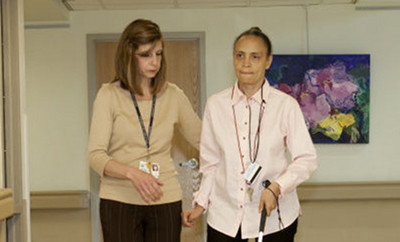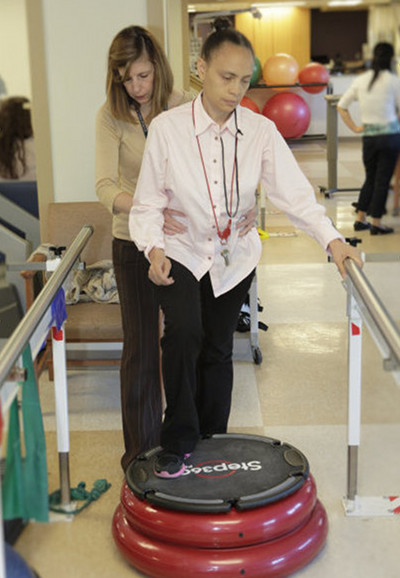
(Living Beyond Disabilities - June/July 2013) In 2009, before illness struck, Stacey Adams fought to make sure minority populations – including people with disabilities – received equitable treatment and opportunities. It was her job as chief diversity officer for Rohm and Haas. It was her passion, as well.
“My whole purpose was around giving equal opportunity to individuals,” she says. “Making visible the invisible. That was my passion and purpose in life. Unfortunately, I just find it so ironic that now I am ‘they.’ I am one of those individuals who now needs the help. Is invisible in certain situations.”
Adams was working toward a Ph.D. in diversity and leadership and served on several nonprofit boards four years ago when she was diagnosed with neuromyelitis optica (NMO), a devastating disease of the nervous system that generally affects the optic nerves and the spinal cord. About 4,000 people have been diagnosed with NMO in the U.S., according to the Guthy Jackson Charitable Foundation, which funds work to prevent, treat and cure the disease.
It is a condition that has led Adams, now 47, through some difficult years. The condition first reared its head in October of 2009 when she fell asleep - after suffering severe headaches - and didn’t wake up again for seven days. When she finally awoke she found she was paralyzed from the neck down and couldn’t speak. That attack ultimately led to a diagnosis from the Mayo Clinic of NMO, which is also known as Devic’s disease.
A second attack
Adams regained her speech and was improving her ability to walk when the disease struck again – undoing the gains and leaving her paralyzed below the neck and unable to see out of one eye. Weeks later, another attack occurred.
“I’ll never forget the emotion I had,” she says. “I was sitting on my hospital bed. I was looking in the mirror one day, and I went to blink my eyes—and granted I was blind in one eye—and I opened my eyes up and I was blind in the other eye.”
Nine months of in-home therapy followed, but she wasn’t satisfied with the progress.
Adams, the mother of a 13-year-old daughter, came through the doors of MossRehab’s main campus in Elkins Park in 2011. She had regained the ability to think clearly and logically, but still had some memory impairment, could not see out of either eye and needed work on walking and daily activities.
“She came in at a very low level,” says Stephen G. Whittaker, Ph.D., an occupational therapist at MossRehab who has been working with Adams for nearly 20 months. “She came in pretty much dependent for everything.”
“I could not dress myself. I could not wash myself. I could not feed myself,” Adams explains.
Whitaker adds that she couldn’t stand or transfer herself out of her wheelchair. Couldn’t push her wheelchair or tackle day-to-day activities.
Adding to her challenges, Adams had lost the ability to see pictures in her head, meaning she can’t mentally visualize where she is in space (or summon her daughter’s face). She has weakness in her legs, impaired sensation throughout her body, difficulty moving her left leg, no feeling in her right arm and limited sense of body awareness.
“It was a struggle for her,” Whitaker says. “She had good days and bad days.”
Not Accepting Limits
Adams remained determined.
 “I did not know what my limits were,” she says. “I was determined to go beyond what I was told I could do.”
“I did not know what my limits were,” she says. “I was determined to go beyond what I was told I could do.”
Because of the combination of blindness with spinal cord damage, MossRehab’s usual team approach became even more crucial. Whitaker, who is also a certified low vision therapist, worked closely with physical therapist Michele Aguado, speech pathologist Pippa Siguenza and an orientation and mobility expert, along with the rest of the team.
“I’ve made significant progress,” Adams says two years later. “I am now able to walk with either the white cane, which is typically used by people who are sight impaired, or with a walker, which I use around the home, or with a one-person assist. I am able to get around that way, which is great. I’m able to do my basic daily activities. I can do everything except for cook. I try as best I can to maintain my home and take care of my daughter.”
It is enough progress for her therapists at MossRehab to feel she is ready to move on.
“We think she is ready to swim, and we think she needs to go out there and swim,” Whitaker says.
Today Adams lives in her own home in the Mt. Airy section of Philadelphia, with her daughter and a live-in aide. And she is beginning to turn her attention toward her old passion, where becoming part of the “they” has made Adams that much more determined.
“[I see first hand] how the world views you and the world treats you and [how] they will look at the physical ability and then determine … the intellectual ability. That probably is the most heart-wrenching part of this disease for me.”
Which leads to her longer-range plans:
“I am going to try to continue to use my voice to bring awareness to this disease, to learn as much as possible about this disease, and to, hopefully, educate people around the need for more compassion toward people like myself. [I] may physically be disabled, but there is nothing wrong with my mind.
As her time at MossRehab comes to an end, Adams says her feeling of satisfaction is mixed with anxiety.
“MossRehab has been a huge factor not just in my physical recovery but my emotional recovery and my psychological recovery. Just being in the midst of other people who are struggling and who are determined to do better tends to help me with those feelings of isolation. The negative part for me is now I have to find outlets for socialization. I have to now put myself out there in ways that I haven’t had to do.”
Looking back over the past three years of her life, Adams offers a hard assessment, noting that her sight has not returned, she is in constant pain and she battles to tackle chores that come easily to others.
“It’s tough,” she says. “Never in my wildest dreams could I have envisioned this to be my future or this to be my reality. Never.”
So the question inevitably arises about what keeps her going.
“My daughter. That keeps me optimistic. I want to be here, and I want to be around to raise her in an active way, not a passive way. That is my biggest motivation,” she says.
It goes deeper.
“I think the other motivating force is I don’t like to feel defeated. I’m going to try my best to try whatever I can to work with my body because I don’t believe this is the end for me. My spirituality is very important to me. I just don’t believe that this is what God has [in mind] for me to stop here. I may never regain my sight. I may never regain my physical abilities. However, there is still a place for me. There is still a place to use my voice to be an advocate—to do the same things I did when I was well. To bring voice to the voiceless to bring visibility to the invisible. I just do it in a different way.”